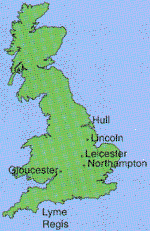
Figure 1. Locality map showing the outcrop pattern of the Marlstone Rock Bed across southern and central England (ref. 1, main article).
[Geological conflict: Young radiocarbon date for ancient fossil wood challenges fossil dating by Andrew Snelling] For most people, the discovery of fossilised wood in a quarry would not be newsworthy. However, some pieces recently found embedded in limestone alongside some well-known 'index' fossils (see aside below) for the 'Jurassic period' (supposedly 142-205.7 million years ago) have proved highly significant.
It is not generally realised that index fossils are still crucial to the millions-of-years geological dating, in spite of the advent of radioactive 'dating' techniques. Not all locations have rocks suitable for radioactive 'dating', but in any case, if a radioactive 'date' disagrees with a fossil 'date' then it is the latter which usually has precedence.

The Marlstone Rock Bed is a distinctive limestone unit that outcrops from Lyme Regis on the Dorset coast of southern England, north-eastwards to just west of Hull near the North Sea coast (Figure 1).1 In many places, the top 5-30 cm (2-12 inches) or more of this bed has been weathered and altered, the original green iron minerals2 being oxidized to limonite (hydrous iron oxides), and also in a few areas the sand content is higher. In the past, the outcrop has been quarried frequently for iron ore or building stone.
Evolutionary geologists consider that the top three metres (10 feet) of the Marlstone Rock Bed represent the whole of the Tenuicostatum Zone, the basal zone of the Toarcian Stage,1 the last stage of the Early Jurassic. This 'dating' is based on the presence of the ammonite index fossil Dactylioceras tenuicostatum.1
Thus the bed is said to be about 189 million years old according to the geological time-scale.3
Amongst the remaining quarries still 'working' the top of the Marlstone Rock Bed are the Hornton Quarries at Edge Hill near the village of Ratley, on the north-western edge of the Edge Hill plateau, some 10½ km (6½ miles) north-west of the town of Banbury (Figures 2 and 3). Building stone, known as 'Hornton Stone', has been quarried there since medieval times.4,5
During two visits to the Hornton Quarries, it was established that fossil wood occurs alongside ammonite and belemnite index fossils (see aside below) in the 'Hornton Stone', the oxidized silty top of the Marlstone Rock Bed. The ammonite recovered in the quarries is Dactylioceras semicelatum (Figure 4), abundant in a subzone of the Tenuicostatum Zone.1 Fossil wood was actually found sitting on top of a fossilised belemnite (Figure 5), probably belonging to the genus Acrocoelites, a Toarcian Stage index fossil in north-west Europe.6 Many such belemnite fossils had been found during quarrying operations (Figure 6). Together these index fossils have, in evolutionary reckoning, established the rock containing them as being Early Jurassic and about 189 million years old.1,3 Logically, the fossil wood must be the same 'age'.
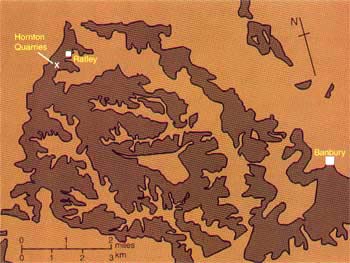
Pieces of all three samples were sent for radiocarbon (14C) analyses to Geochron Laboratories in Cambridge, Boston (USA), while as a cross-check, a piece of the first sample was also sent to the Antares Mass Spectrometry Laboratory at the Australian Nuclear Science and Technology Organisation (ANSTO), Lucas Heights near Sydney (Australia). Both laboratories are reputable and internationally recognised, the former a commercial laboratory and the latter a major research laboratory.
The staff at these laboratories were not told exactly where the samples came from, or their supposed evolutionary age, to ensure that there would be no resultant bias.
Both laboratories used the more sensitive accelerator mass spectrometry (AMS) technique for radiocarbon analyses, recognised as producing reliable results even on samples with minute quantities of carbon.
The radiocarbon (14C) results are listed in Table 1. Obviously, there was detectable radiocarbon in all the fossil wood samples, the calculated 14C 'ages' ranging from 20,700 ± 1,200 to 28,820 ± 350 years BP (Before Present).
For sample UK-HB-1, collected from on top of the belemnite index fossil (Figure 5), the results from the two laboratories are reasonably close to one another within the error margins, and when averaged yield a 14C 'age' almost identical (within the error margins) to the 22,730 ± 170 years BP of sample UK-HB-2.
Alternatively, if all four results on the three samples are averaged, the 14C 'age' is almost identical (within the error margins) to the Geochron result for UK-HB-1 of 24,005 ± 600 years BP. This suggests that a reasonable estimate for the 14C 'age' of this fossil wood would be 23,000-23,500 years BP.
Quite obviously this radiocarbon 'age' is drastically short of the 'age' of 189 million years for the index fossils found with the fossil wood, and thus for the host rock.
Of course, uniformitarian geologists would not even test this fossil wood for radiocarbon. They don't expect any to be in it, since they would regard it as about 189 million years old due to the 'age' of the index fossils. No detectable 14C would remain in wood older than about 50,000 years. Undoubtedly, they would thus suggest that the radiocarbon, which has been unequivocally demonstrated to be in this fossil wood, is due somehow to contamination. Such a criticism is totally unjustified (see aside two).
The fossil wood in the top three metres of the Marlstone Rock Bed near Banbury, England, has been 14C 'dated' at 23,000-23,500 years BP. However, based on evolutionary and uniformitarian assumptions, the ammonite and belemnite index fossils in this rock 'date' it at about 189 million years. Obviously, both 'dates' can't be right!
Furthermore, it is somewhat enigmatic that broken pieces of wood from land plants were buried and fossilised in a limestone alongside marine ammonite and belemnite fossils. Uniformitarians consider limestone to have been slowly deposited over countless thousands of years on a shallow ocean floor where wood from trees is not usually found.
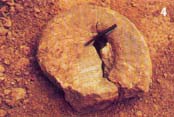
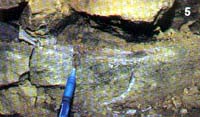
However, the radiocarbon 'dating' of the fossil wood has emphatically demonstrated the complete failure of the evolutionary and uniformitarian assumptions underpinning geological 'dating'.
A far superior explanation for this limestone and the mixture of terrestrial wood and marine shellfish fossils it contains is extremely rapid burial in a turbulent watery catastrophe that affected both the land and ocean floor, such as the recent global biblical Flood.
The 23,000-23,500 year BP 14C 'date' for this fossil wood is not inconsistent with it being buried about 4,500 years ago during the Flood, the original plants having grown before the Flood.
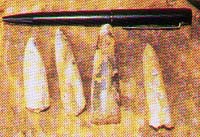
Thus, correctly understood, this fossil wood and its 14C analyses cast grave doubts upon the index fossil 'dating' method and its uniformitarian and evolutionary presuppositions. http://www.answersingenesis.org/articles/cm/v22/n2/geology